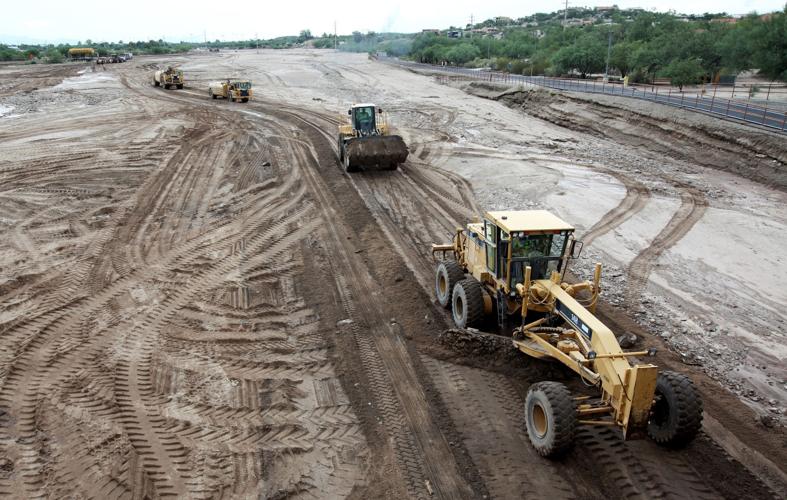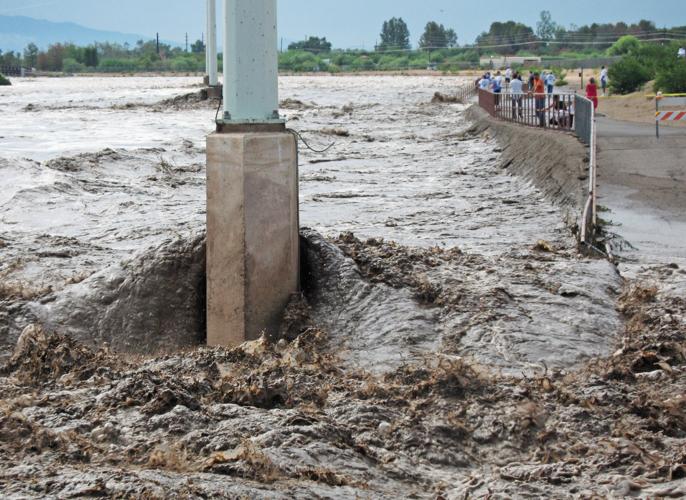Tamarisks, mesquites and desert shrubs are gone from a big swath of the Rillito River, removed by Pima County as part of a $1 million flood control job.
County flood control officials say the work this summer — which also pulled out 225,000 cubic yards of dirt — was necessary to lower the riverbed and reduce the risk of flooding, which could have overtopped the Rillito in an area where thousands of people live.
The three-month-long project went from Alvernon Way on the west to about halfway between Swan and Craycroft roads on the east.
The clearing didn’t go over too well with some neighbors and the Tucson Audubon Society. But county flood control officials say they’ll likely have to clear out more trees, shrubs and dirt next spring from the Santa Cruz River through the heart of Tucson’s urban core, for similar reasons.
At issue is the balance between plant life and public safety, and between wildlife habitat and potentially wild flooding. The tradeoffs occur even though the county spent millions of dollars lining these washes in the 1980s and ’90s with soil cement to keep banks from crumbling from flood erosion.
No matter what society does to try to control flooding, rivers can’t always be controlled.
“You can’t just build bank protection and then walk away from it. You have to constantly be monitoring the conditions of the channel itself and do maintenance activities where necessary,” said Suzanne Shields, director of the County Regional Flood Control District.
But Marcella Vasquez and Dan Duncan, who live just north of the Rillito east of Swan Road, think the clearing was too sweeping.
“Why did they not just make the channel deeper in the center and leave vegetation on the sides?” said Duncan. “I certainly understand the need for sediment removal, but I am confused as to why they had to do bank-to-bank removal.”
Shields countered that digging deeper isn’t possible, due to a soil cement lining, and wouldn’t be wise because it could allow the water to scour into the channel and undermine the river’s bank protection.
FLOOD RISK BUILT UP OVER the YEARS
Most of the soil cement was lined along both rivers after Tucson’s Great Flood of 1983 ripped out stream banks on many of the region’s washes. Several condominiums and a major office building fell into the Rillito after the banks washed away.
The Rillito soil cement from Alvernon to Craycroft was installed in 1996, while the Santa Cruz soil cement went in during the 1980s.
The cement lining has since survived three decades of flooding. But sediment has gradually built up in both streams, raising the riverbed.
The huge 2006 flood “gouged” the Catalina Mountains and dumped large amounts of rock and sediment into Sabino Canyon and ultimately, other streams including the Rillito, said David Yetman, who was heavily involved in flooding issues as a Pima County supervisor from 1976 to 1988.
A large flood could flush it from the system. But if there isn’t a big event, the sediment accumulates during smaller events and reduces the river’s capacity to carry water, said Victor Baker, a University of Arizona professor of hydrology, water resources and geosciences, who has studied flood risks for decades.
The trees and shrubs that have grown in the Rillito held down soil that might otherwise have washed downstream, aggravating the sediment buildup, Shields said.
Now, the riverbed stands 5 to 8 feet higher than in 1996, Shields said. A big flood could spread into neighboring homes, she said.
Some of that sediment buildup is possibly due to the soil cement banks themselves, said Yetman and Baker. Soil that once spread out over the river has nowhere to go.
“We’ve changed the whole process and created an artificial situation,” said Baker. “But it’s not a simple thing — you can say (the soil cement) is part of the chain of things.”
As recently as last fall, Shields downplayed the risk of a flooding problem on the Rillito. In an interview at the time, she said the soil cement channel was originally designed to contain more than a 100-year flood.
But after doing a computer analysis and looking more closely at topographic maps of the area, authorities concluded the flooding risks were worse than thought, and ordered the clearing and sediment removal, she said last week.
NEIGHBORS, AUDUBON DISAPPOINTED
Shields said the county got in touch with several neighborhood associations along the Rillito in advance of the work. Some neighbors said they didn’t feel adequately informed.
“We just got a message from our homeowners association with an attachment, from the county. It was a very vague letter that said, ‘We’re doing work.’ It didn’t say anything like, ‘We’re going to rip out the vegetation,’” said Kristen Brady, who lives south of the river in the Creekside subdivision near Fort Lowell and Columbus roads.
Duncan, who has lived near the Rillito for 20 years, said, “We go out in the river, ride our horses or walk there, and you see all kinds of wildlife. There is a resident bobcat that traverses that area all the time, but I haven’t seen it since they started scraping the Rillito. I’d see coyote packs out there all the time, but none since the construction,” he said.
Brady said she lacks scientific knowledge to judge whether the county’s flood control effort was advisable. But she said, “It’s sad to see the cleared wash and difficult to listen to the machines every day.”
Also upset at some of the county’s work was the Tucson Audubon Society. It cited the clearing of what was known as a weed patch near the river and Columbus that contained mesquite, cottonwood and non-native trees and was a birding “hot spot,” said Karen Fogas, the society’s executive director.
Society members were particularly concerned that they hadn’t been told the patch would be cleared. Shields said county officials didn’t realize it was an important area to birders. Audubon was concerned because some of that clearing took place during nesting season. That area will be reseeded and replanted, Shields said.
“We do understand that given the changes that have been made to the river and development along the river, there has to be a priority on human habitation,” Fogas said. “That emphasizes how critical it is that we preserve important areas like the weed patch, that we think about it before it’s destroyed.”
SANTA CRUZ IS NEXT
On the Santa Cruz, a new report by a Pima County consultant used computer analysis to conclude the river from Grant Road to 22nd Street has risen up to 10 feet since 1983. The rise is particularly high near the Congress and 22nd Street bridges.
The Speedway and Congress bridges were designed in the 1950s to handle a flow of about 14,000 cubic feet per second, but the 100-year flood that hit in 1983 peaked at 55,000 cubic feet per second, said Shields.
“I remember driving ... under the Speedway interchange (at Interstate 10) and the high water mark was two feet over the bridge” in the 1983 flood, said Shields, a native Tucsonan. “Now, it would be worse.
“There wasn’t home flooding then but there wasn’t as much development there then,” she said. “It didn’t matter if it got out of the channel. If it got out of the channel now, there could be flooding in homes and businesses.”
A substantial amount of clearing may be needed, especially near the Congress and Speedway bridges, she said.
“The fear is that vegetation would get uprooted in a big storm and would pack up against the bridges and the bridges could fail,” Shields said.
Because of the complexity of the job, the concerns already expressed by neighbors and the need to work with Tucson and Rio Nuevo, the county will do a lot of coordinating first, Shields said. A federal Clean Water Act permit will be needed from the Army Corps of Engineers.
When county flood control official Andy Dinauer came to talk to neighbors from Menlo Park west of downtown about this issue in the spring, they expressed concern about the prospect of land clearing and soil excavation.
“That habitat is very important environmentally and it adds beauty to the river,” said Gene Einfrank, president of the Menlo Park Neighborhood Association. “I went to the Rillito where the clearing occurred ... and I was shocked when I saw it.
“At our meeting last spring, Andy said the county would be picking and choosing vegetation, they’d take out invasive species and leave indigenous plants. That sounded good. When I saw what they did on the Rillito, it didn’t look like that’s what they were doing.”





